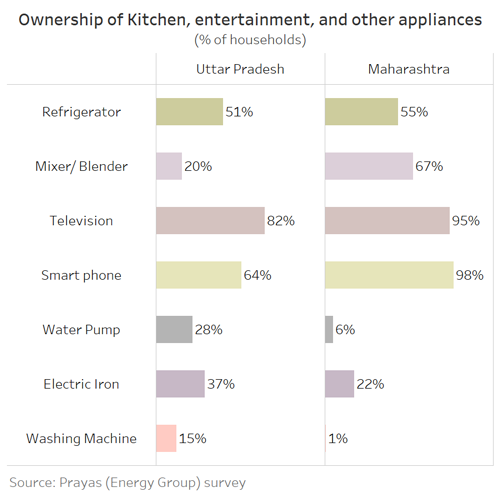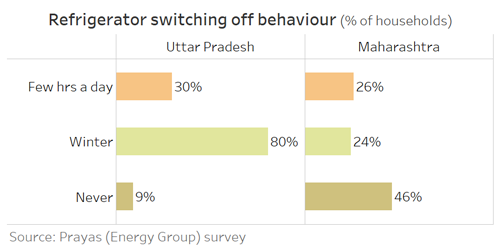Prayas (Energy Group) conducted a survey of 3000 households in semi-urban and rural areas of Uttar Pradesh and Maharashtra to understand their energy end-use patterns. This survey was conducted in February-March 2019. ECHO is a series of blog posts presenting the key findings of the survey. This post discusses households’ use of electricity for refrigeration, entertainment, and other applications.
Sampling plan and household categorization are briefly described here.
Beyond the basic uses of lighting and space-conditioning, people use electricity for a host of appliances which reduce drudgery and improve quality of life. As the household’s income increases, the use of these appliances increases significantly adding to its electricity consumption. In this post we discuss the usage patterns of these appliances in the surveyed households.

Figure 1: Ownership of kitchen, entertainment, and other appliances
Kitchen appliances
Refrigerator is the most common kitchen appliance. There are two types of refrigerators: frost-free and direct-cool. Frost-free refrigerators are generally larger in size, cost more, consume more electricity, and do not require manual defrosting as compared to direct-cool refrigerators. More than 10 million refrigerators are sold annually with a significant share of direct-cool refrigerators. Standards and Labeling (S&L) programme is mandatory for both types of refrigerators meaning no refrigerator can be sold in the market without a star label.
About 51% of the surveyed households in Uttar Pradesh and 55% in Maharashtra own a refrigerator (see Figure 1). The ownership is more than 90% in the high income households and about 10% in the low income households in both the states. About 96% of these households in Uttar Pradesh and 89% in Maharashtra own a direct-cool type of refrigerator. This suggests that the ownership of the frost-free refrigerators is limited to the urban and large metro cities. About 50% of the households with a refrigerator either do not know about star-ratings or report owning a non star-rated refrigerator. The S&L programme was made mandatory for direct-cool refrigerators four years ago, in 2015. The average age of refrigerators in the sample is about 7 years in both states which probably explains the higher share of non star rated appliances. BEE has periodically revised the star-ratings upward since its launch but the companies have been slow in introducing new 4 star and 5 star models. This is reflected in the survey with only about 31% of surveyed households in Uttar Pradesh and 37% in Maharashtra owning the energy efficient four and five star models.

Figure 2: Refrigerator switching off behaviour
We also observed that about 80% of the surveyed households across all income categories in Uttar Pradesh switch off their refrigerators in winters. The number is low at 24% in Maharashtra. Furthermore, about 30% of the surveyed households in Uttar Pradesh and 26% in Maharashtra switch off their refrigerators every day for a few hours. Households may be trying to reduce their electricity bills by limiting the use of refrigerator. One other reason may also be the social practices around cooking like buying fresh food and cooking just before meal-time which makes the use of refrigerator redundant. Anecdotal evidence from Uttar Pradesh suggests that people in semi-urban and rural areas use refrigerator only for cooling water/beverages in summers. Models on India’s residential electricity consumption as well as the calculations to estimate savings from the S&L programme should account for this behavior to avoid over-estimation.
Mixer-blender is another kitchen appliance whose ownership is high, particularly in Maharashtra. About 60% of households use mixer-blender at least once a week in Maharashtra compared to 20% in Uttar Pradesh. Although its contribution to the household’s total electricity consumption is less as it is used for only a few minutes per day, it drastically reduces the drudgery of manual grinding. The ownership and use of mixer-blender may also depend on cooking practices similar to refrigerator.
Television & other appliances
India has a large television market with reported sales of about 10 million in 2018 with a large share of LCD/LED TVs. This is reflected in the high ownership in the surveyed households in both the states: about 82% in Uttar Pradesh and 95% in Maharashtra (see figure 1). Interestingly, about 65% of the televisions in both the states are the Cathode Ray Tube (CRT) type. This suggests that either the TVs are old and were bought before the fall in the prices of LED TVs or there is a large second-hand market where CRT TVs are sold at prices much lower than that of LED TVs. This can have an impact on the overall efficiency as LED TVs are much more efficient than a CRT TV. S&L programme is mandatory for TVs. However, about 86% of the households in Uttar Pradesh and 81% in Maharashtra did not know about star-rating programme for TVs. According to BEE, a 5 star TV with screen size 29 inches can consume 30% less than a 1 star TV based on the assumption of 6 hours of daily watching. The surveyed households in Uttar Pradesh reported watching 5 hours of TV a day while the number was 4 hours in Maharashtra.
Smart-phone ownership is high in both states, about 64% in Uttar Pradesh and 98% in Maharashtra. There are about 2 smart-phones per household in both the states. Interestingly, about 47% of the households in Uttar Pradesh reported watching any sort of media like TV, news, or movies on mobile while the number was only 2% in Maharashtra. Although the direct impact of smart-phones on household’s electricity consumption is small the high ownership of smart-phones may impact the use of electricity and energy in different ways. Increased use of smart-phones for media may impact the use of TVs in the future. High ownership of smart-phones can enable provision of various value-added services from distribution utilities, appliance manufacturers and other technology providers which can change the way how households use energy.
Individual house-level water pump is another most-used appliance, particularly in Uttar Pradesh. About 28% of households in Uttar Pradesh use water pump at least once a week while the number being only 6% in Maharashtra. These water pumps are used from half an hour to one hour per day on an average. Normally these pumps consume about 1 horsepower (746 Watts). A daily use of water-pumps can significantly add to the household’s electricity consumption. BEE’s S&L programme does not cover water pumps.
In the next post, we explore water-heating, an end-use for which households use multiple fuel sources.
Please contact Aditya Chunekar (
Click here to access other posts in the blog
This post was translated and published by Eklavya in their Hindi magazine Srot (Vigyan evam technology features). This translation is available here.


